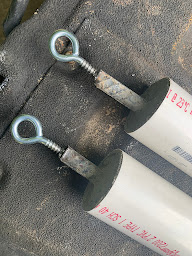I'm just wrapping up the latest antenna farm project with the addition of an active receive-only loop. This came out of a need to improve my lower HF bands receive capability and help deal with local manmade noise in the neighborhood. The antenna + preamp combination I chose is the DX Engineering Pro-1B.
The system is located about 250' behind the house in the woods -- away from noise sources and neighbors. The antenna is ground mounted on about 10 feet of electrical conduit, with 2 feet of the mast embedded in a concrete filled hole about 8" across. To rotate the loop, a Yaesu G-450ADC light duty rotor with the optional mast mount kit is installed about 3' from the bottom of the loop. Belden 75 ohm quad shield coax carries the RF from the preamp as well as DC to power the preamp. The Yaesu rotor requires (4) 18 gauge wires, and I found "outdoor" 4 wire speaker cable (eBay) does the trick economically.
To combat any common mode noise finding its way into the preamp / antenna -- I wrapped several feet of coax (about 8 turns) on a mix 31 ferrite toroid just before the feed line connects to the output of the preamplifier. All coax and control connections are sealed with layers of Scotch 33+ electrical tape followed by Scotchkote. (This weatherproofing method has been successful here -- I've just unwrapped connections sealed this way from 21 years ago and they are still pristine. It takes extra time and can be messy...but well worth it.)
My initial impressions are very positive given that summertime isn't exactly "quiet" on the lower bands. I'm testing it with an RSP-Duo SDR, and although signal levels are lower than what I'm used to on other wire antennas, the noise levels have fallen more than the signals ==> hence, a better SNR. These bands have never sounded so clean, and should I see any noise (and I do from some SMPS next door) -- the loop will null that noise out when broadside to the noise source. So far, so good.
 |
| Pro-1B Loop Antenna & Preamp |
 |
| Mix 31 Toroid at Preamp |



